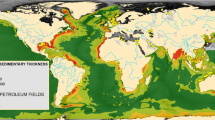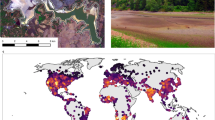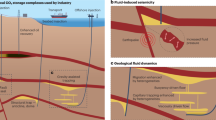Abstract
Fossil fuel power generation and other industrial emissions of carbon dioxide are a threat to global climate1, yet many economies will remain reliant on these technologies for several decades2. Carbon dioxide capture and storage (CCS) in deep geological formations provides an effective option to remove these emissions from the climate system3. In many regions storage reservoirs are located offshore4,5, over a kilometre or more below societally important shelf seas6. Therefore, concerns about the possibility of leakage7,8 and potential environmental impacts, along with economics, have contributed to delaying development of operational CCS. Here we investigate the detectability and environmental impact of leakage from a controlled sub-seabed release of CO2. We show that the biological impact and footprint of this small leak analogue (<1 tonne CO2 d−1) is confined to a few tens of metres. Migration of CO2 through the shallow seabed is influenced by near-surface sediment structure, and by dissolution and re-precipitation of calcium carbonate naturally present in sediments. Results reported here advance the understanding of environmental sensitivity to leakage and identify appropriate monitoring strategies for full-scale carbon storage operations.
This is a preview of subscription content, access via your institution
Access options
Subscribe to this journal
Receive 12 print issues and online access
$209.00 per year
only $17.42 per issue
Buy this article
- Purchase on Springer Link
- Instant access to full article PDF
Prices may be subject to local taxes which are calculated during checkout




Similar content being viewed by others
References
IPCC Third Assessment Report of the Intergovernmental Panel on Climate Change (IPCC) (Cambridge Univ. Press, 2001).
Raupach, M. R. et al. Global and regional drivers of accelerating CO2 emissions. Proc. Natl Acad. Sci. USA 104, 10288–10293 (2007).
IPCC in IPCC Special Report on Carbon Dioxide Capture and Storage (eds Metz, B., Davidson, O., de Coninck, H. C., Loos, M. & Meyer, L. A.) 442 (Cambridge Univ. Press, 2005).
Senior, B. CO2 Storage in the UK—Industry Potential, DECC, URN 10D/512, 2010.
Nakanishi, S. et al. Methodology of CO2 aquifer storage capacity assessment in Japan and overview of the project. Energy Procedia 1, 2639–2646 (2009).
Austen, M. C. et al. The UK National Ecosystem Assessment Technical Report (UNEP-WCMC, 2011).
Van Noorden, R. Carbon sequestration: Buried trouble. Nature 463, 871–873 (2010).
Monastersky, R. Seabed scars raise questions over carbon-storage plan. Nature 504, 339–340 (2013).
IEA Greenhouse Gas R&D Programme (IEA GHG) Assessment of sub-sea ecosystem impacts (2008).
Widdicombe, S., Blackford, J. C. & Spicer, J. I. Assessing the environmental consequences of CO2 leakage from geological CCS: Generating evidence to support environmental risk assessment. Mar. Pollut. Bull. 73, 399–401 (2013).
Caramanna, G., Voltattorni, N. & Maroto-Valer, M. Is Panarea Island (Italy) a valid and cost-effective natural laboratory for the development of detection and monitoring techniques for submarine CO2 seepage? Greenhouse Gases: Sci. Technol. 1, 200–210 (2011).
Carey, S. et al. CO2 degassing from hydrothermal vents at Kolumbo submarine volcano, Greece, and the accumulation of acidic crater water. Geology 41, 1035–1038 (2013).
Boudreau, B. P. et al. Bubble growth and rise in soft sediments. Geology 33, 517–520 (2005).
Algar, C. K., Boudreau, B. P. & Barry, M. A. Initial rise of bubbles in cohesive sediments by a process of viscoelastic fracture. J. Geophys. Res. 116, B04207 (2011).
Jain, A. K. & Juanes, R. Preferential mode of gas invasion in sediments: Grain-scale mechanistic model of coupled multiphase fluid flow and sediment mechanics. J. Geophys. Res. 114, B08101 (2009).
Leighton, T. G. & White, P. R. Quantification of undersea gas leaks from carbon capture and storage facilities, from pipelines and from methane seeps, by their acoustic emissions. Proc. R. Soc. A 468, 485–510 (2012).
Mucci, A. et al. Fate of carbon in continental shelf sediments of eastern Canada: A case study. Deep-Sea Res. II 47, 733–760 (2000).
Aller, R. C. & Aller, J. Y. The effect of biogenic irrigation intensity and solute exchange on diagenetic reaction rates in marine sediments. J. Mar. Res. 56, 905–936 (1998).
Janssen, F., Huettel, M. & Witte, U. Pore-water advection and solute fluxes in permeable marine sediments (II): Benthic respiration at three sandy sites with different permeabilities (German Bight, North Sea). Limnol. Oceanogr. 50, 779–792 (2005).
Duan, Z., Hu, J., Li, D. & Mao, S. Densities of the CO2–H2O and CO2–H2O–NaCl systems up to 647 K and 100 MPa. Energ. Fuel. 22, 1666–1674 (2008).
Anderson, L. G. et al. Benthic respiration measured by total carbonate production. Limnol. Oceanogr. 31, 319–329 (1986).
Gattuso, J. P., Hansson, L. (eds) Ocean Acidification 326 (Oxford Univ. Press, 2011).
DeBeer, D. et al. In situ fluxes and zonation of microbial activity in surface sediments of the Håkon Mosby mud volcano. Limnol. Oceanogr. 51, 1315–1331 (2006).
Lichtschlag, A. et al. Methane and sulfide fluxes in permanent anoxia: In situ studies at the Dvurechenskii mud volcano (Sorokin Trough, Black Sea). Geochim. Cosmochim. Acta. 74, 5002–5018 (2010).
Decker, C. et al. Habitat heterogeneity influences cold-seep macrofaunal communities within and among seeps along the Norwegian margin. Part 1: Macrofaunal community structure. Mar. Ecol. 33, 205–230 (2012).
Gruenke, S. et al. Niche differentiation among mat-forming, sulfide-oxidizing bacteria at cold seeps of the Nile Deep Sea Fan (Eastern Mediterranean Sea). Geobiology 9, 330–348 (2011).
Felden, J. et al. Limitations of microbial hydrocarbon degradation at the Amon mud volcano (Nile deep-sea fan). Biogeosciences 10, 3269–3283 (2013).
Blackford, J. C., Jones, N., Proctor, R. & Holt, J. Regional scale impacts of distinct CO2 additions in the North Sea. Mar. Pollut. Bull. 56, 1461–1468 (2008).
Dewar, M., Wei, W., McNeil, D. & Chen, B. Small scale modelling of the physiochemical impacts of CO2 leaked from sub-seabed reservoirs or pipelines within the North Sea and surrounding waters. Mar. Prod. Bull. 73, 504–515 (2013).
Thomas, H. et al. Controls of the surface water partial pressure of CO2 in the North Sea. Biogeosciences 2, 323–334 (2005).
Shitashima, K., Kyo, M., Koike, Y. & Henmi, H. Proceedings of the 2002 International Symposium on Underwater Technology 106–108 (IEEE, 2002).
Clarke, K. R. Non-parametric multivariate analyses of changes in community structure. Aust. J. Ecol. 18, 117–143 (1993).
Kruskal, J. B. & Wish, M. Multidimensional Scaling (Sage Publications, 1978).
Acknowledgements
Funding was provided by NERC (NE/H013962/1), the Scottish Government and METI/MEXT of Japan. We thank the Tralee Bay Holiday Park, Lochnell Estates and the inhabitants of Benderloch for hosting the experiment. We acknowledge Marine Scotland and The Crown Estate for permissions to carry out the research. The NERC National Facility for Scientific Diving, the crew of the RV Seol Mara and J. Montgomery based at SAMS provided operational support. We thank A. Skinner of ACS coring services for advice on the drilling, and the design of the well screen; J. Davis for support of geophysical data acquisition; C. Wallace of Kongsberg Ltd for provision and processing of the multibeam bathymetry data; J. Gafiera (BGS) for interpretation of site survey seismic profiles and A. Monaghan (BGS) for construction of 3D geological models.
Author information
Authors and Affiliations
Contributions
R.H.J., D.C., H.S., S.W., K.S., A.L., P.T., J.K., C.H., K.T., M.S. and M.H. designed and undertook biogeochemical measurements and analysed data; M.C., M.E.V., I.W., D.L., D.S., J.M.B. and M.A. planned, acquired and interpreted seismic reflection data; T.G.L., P.R.W. and B.J.P.B. designed and undertook passive acoustic measurements, analysed data and completed gas flux inversion; T.M.G. analysed and interpreted core data; B.C. analysed bubble dynamics from bottom photographs; M.D.J.S. led the diving deployment and sampling strategy; B.C., H.K. and T.S. developed models to constrain the experimental deployment; D.L., D.S. and M.A. developed the concept, design and implementation of the borehole and gas delivery mechanism; H.S., P.T. and M.N. designed and built the CO2 injection facility; H.S. led and coordinated the release and sampling strategy; J.B., H.S., I.W., R.H.J., J. K., B.C., C.H., S.W. and M.N. conceived the study; J.B. led the project; D.S., B.J.P.B., M.C. and A.L. produced figures within the manuscript; J.B., H.S. and J.M.B. developed and co-wrote the manuscript. All authors discussed results and commented on the manuscript.
Corresponding authors
Ethics declarations
Competing interests
The authors declare no competing financial interests.
Supplementary information
Rights and permissions
About this article
Cite this article
Blackford, J., Stahl, H., Bull, J. et al. Detection and impacts of leakage from sub-seafloor deep geological carbon dioxide storage. Nature Clim Change 4, 1011–1016 (2014). https://doi.org/10.1038/nclimate2381
Received:
Accepted:
Published:
Issue Date:
DOI: https://doi.org/10.1038/nclimate2381
This article is cited by
-
Monitoring underwater volcano degassing using fiber-optic sensing
Scientific Reports (2024)
-
Turbulence-induced bubble nucleation in hydrothermal fluids beneath Yellowstone Lake
Communications Earth & Environment (2022)
-
The potential of coupled carbon storage and geothermal extraction in a CO2-enhanced geothermal system: a review
Geothermal Energy (2020)
-
Clam feeding plasticity reduces herbivore vulnerability to ocean warming and acidification
Nature Climate Change (2020)
-
A high biodiversity mitigates the impact of ocean acidification on hard-bottom ecosystems
Scientific Reports (2020)



